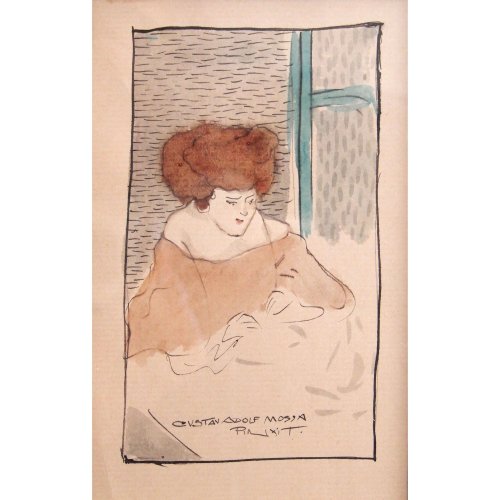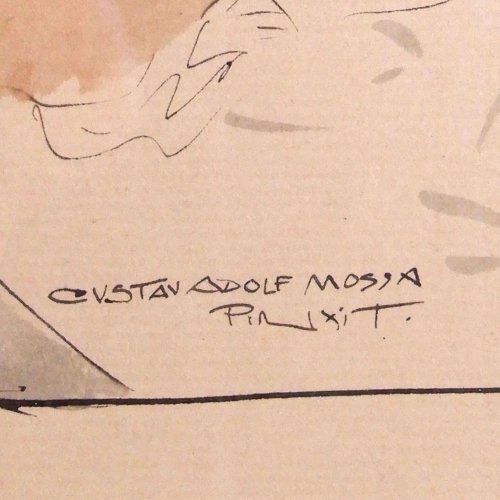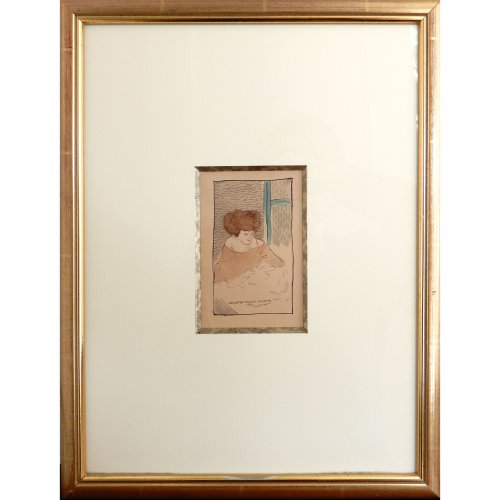Gustave Adolphe Mossa (1883-1971) Young woman in interior
About this piece
A beautifully intimate glimpse, this atmospheric watercolour of a young woman in her interior. She is sitting at a table by the window, likely engaged in some sewing. The watercolour is executed on light brown paper, using only a few colours. The deep reddish-brown of her hair reappears beautifully, though faded, in her sweater, her lips, and of course the paper. The grayish-brown tones of the wallpaper and the rain outside, combined with the green of the window frame, are the only other colours present. The strong lines and shading of the black ink complete the piece. This technique is very characteristic of the renowned French Symbolist painter Gustave Adolphe Mossa. The work was painted between 1900 and 1910, a period during which he used this style of signing.
This was an interesting period for Mossa. After encountering Symbolism during his visit to the 1900 World's Fair and being deeply impressed by the French painter Gustave Moreau, Mossa painted exclusively in this Symbolist style between 1900 and 1911. This marked the peak of his career as a painter. During this time, he created striking works that are now displayed in major museums around the world. For more information, see the biography below.
The work is signed in the middle at the bottom with 'Gustav Adolf Mossa, Pinxit'. (Pinxit is Latin for 'painted it').
Biography:
Gustave Adolphe Mossa (who also signed as Gustav Adolf Mossa), was born in Nice on January 28, 1883, and died on May 25, 1971. He was a French illustrator, playwright, essayist, and Symbolist painter. His mother was Italian and his father, who also painted, was the museum director of the Museum des Beaux Arts in Nice. Mossa succeeded his father as the museum director of the same museum in 1927. In addition to the training he received from his father, he also studied at the École des Arts Décoratifs in Nice until 1900.
In 1900, he visited the famous World's Fair in Paris, where he was deeply impressed by the Symbolist movement, especially by painter Gustave Moreau and writers such as Charles Baudelaire and Stéphane Mallarmé. Together with his father, he worked on the Nice Carnival in 1902, designing numerous posters, costumes, and even an opera. He created illustrations for the work of Robert Schumann, but his most important works were his paintings of women. In his eyes, these women symbolized the decadent and corrupt era since the turn of the century. He painted femmes fatales, lesbians, Biblical women such as Salomé, Delilah, and Judith, and mythological creatures like harpies. These tall, slender, elegant beings always appeared somewhat corrupt upon closer inspection.
In 1911, after a visit to Bruges, Mossa discovered the Flemish Primitives and turned away from Symbolism. He did not want the paintings from his Symbolist period to be exhibited and forbade them from being shown. It was only after his death in 1971 that they became visible to the public again.
Meanwhile, Mossa remained active. After his father's death in 1927, he took over the curatorship of the museum in Nice. There was some criticism because he generously included his own work in the museum's collection (many landscapes). Besides his work as a curator, he wrote several operas and plays and was involved in reviving the local dialect. Additionally, he painted many landscapes of Nice and its surroundings.
Literature:
- Sylvie Lafon & Anne-Marie Clais, 'Gustav Adolf Mossa: La scène symboliste', Nice, Z éditions, 1993.
- Jean Roger Soubiran, 'Gustav Adolf Mossa', Ediriviera & Alligator, 1985
- Collectif Association Symbolique Mossa, 'Gustav-Adolf Mossa; Catalogue raisonné des oeuvres symbolistes', Foreword by Jean Roger Soubiran, Paris, Somogy Éditions d'Art, 2010
Major Museums:
- Musée d'Orsay, Paris
- Musée des Beaux-Arts, Nice
- Musée des Beaux-Arts Belgique, Brussels
Condition
Overall in very good condition, with a small crease in the lower left corner and a small spot in the upper left, near the matting.
Material:
Watercolour, ink on paper
Measurements:
Watercolour:
Length: 13,8 cm
(5,43")
Width: 9 cm
(3,54")
Framed:
Length: 43,5 cm
(17,13")
Width: 33,5 cm
(13,19")
Period:
1900-1910
Origin:
France
Artist / atelier:
Gustave Adolphe Mossa,





